Oil in the Coolant Reservoir (Is It Time to Panic?)
Modern engines rely on proper fluid flow, but mix-ups between oil and coolant cause major issues. Oil in the coolant reservoir indicates contamination that undermines efficiency.
However, this begs the question, “is it time to panic?” We’ll answer this as well as cover how to address cooling system oil contamination and restore proper flow.
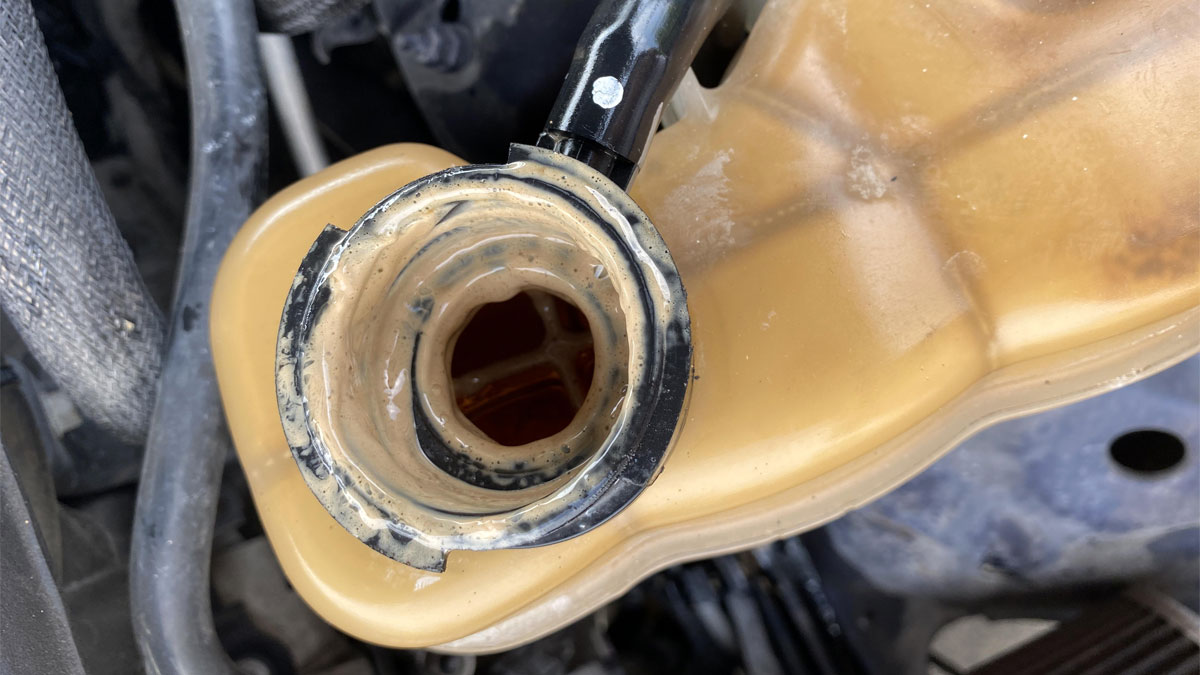
See Also: Oil On Spark Plug Threads (Causes and How to Fix)
What Does Oil in Coolant Look Like?
Oil and coolant do not readily mix. For this reason, a noticeable change occurs in the state of coolant and oil that have come into contact with one another.
Oil-contaminated coolant often takes on a thick, slimy consistency, and appears gray or brown in color. This only grows increasingly evident as contamination becomes more pronounced.

At first, an engine’s cooling reservoir might begin to appear cloudy in appearance when contaminated with oil. As time passes, you might also notice a milky film building within the reservoir itself, often limiting overall visibility.
In the most severe of cases, this mixed substance might also begin to purge from beneath an overflow tank’s cap.
What Can Happen If Oil Gets In Your Coolant?
There are a number of consequences that can arise if oil finds its way into your engine’s coolant. Most prominently, an engine’s capacity to protect itself from overheating will be significantly diminished.
With time, oil/coolant cross-contamination will lead to the plugging of various cooling passages, thereby preventing proper heat-exchanging from taking place.
Furthermore, any time oil appears within an engine’s cooling system, the possibility of coolant entering an engine’s lubricating system should not be overlooked. The consequences of this type of contamination can be devastating to an engine’s bearing and other critical surfaces.
Oil in Coolant vs Coolant in Oil
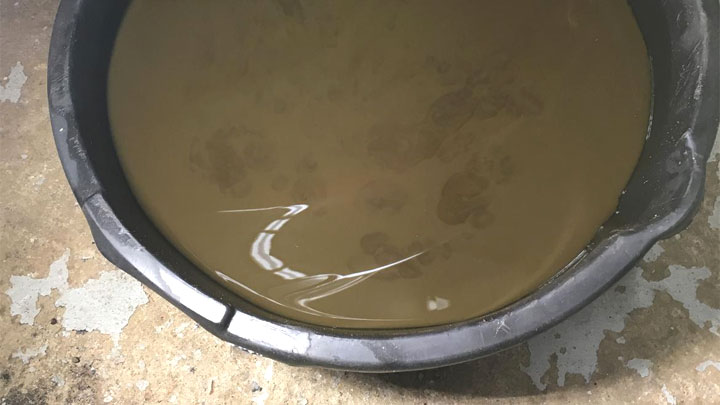
Ideally, an engine’s oil and coolant should never mix. Though these fluids circulate within close proximity to one another at multiple points throughout their path of travel, they should always be sealed from each other, by way of structural means.
Nonetheless, under certain circumstances, oil can find its way into coolant, and coolant into the oil, as the result of one or more issues.
When oil enters an engine’s cooling system, it tends to stop up various cooling passages, including those found within a vehicle’s radiator. This can cause an engine’s cooling efficiency to plunge below ideal rates.
On the contrary, when coolant enters an engine’s lubricating system, oil viscosity is effectively reduced, thereby leaving a number of critical components vulnerable to accelerated wear.
Read Also: Why Is There Oil in My Intake Manifold?
Possible Causes of Oil in Coolant
There are several different reasons that oil might appear in a vehicle’s coolant reservoir. None of these circumstances are ideal and require timely intervention to prevent undue engine damage.
Understanding the possible causes behind this contamination can prove helpful when attempting to return a vehicle to service in an expedited fashion. The following are several of the most prominent causes of oil entering an engine’s cooling system.
#1 – Leaking Head Gasket
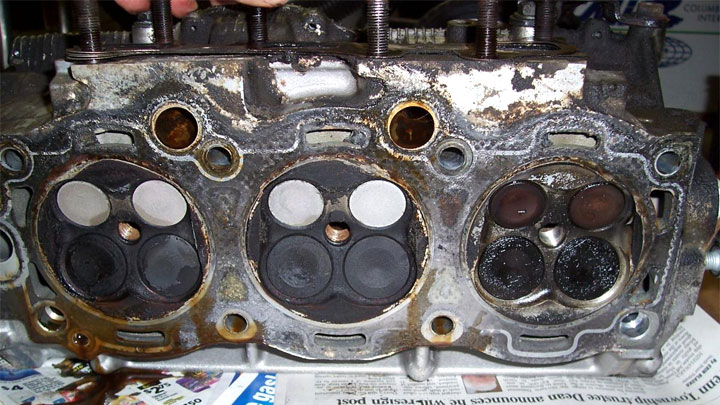
The most common cause of oil contamination within a vehicle’s coolant reservoir is a blown head gasket. An engine’s head gasket seals each respective cylinder head from the engine block itself.
This sealing action also prevents the mixing of oil, coolant, and compression gasses.
#2 – Cracked Cylinder Head/Block
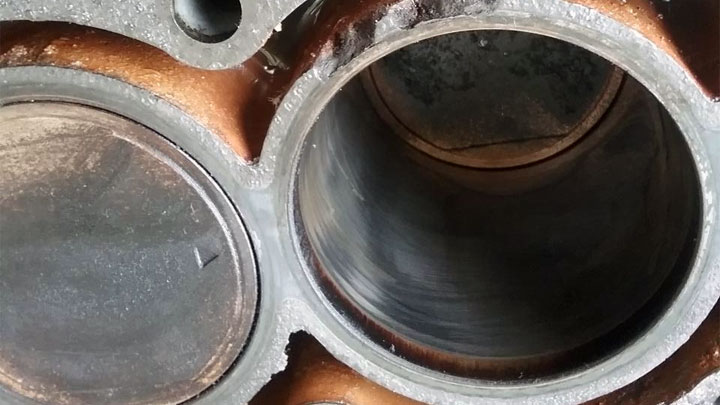
In rare cases, the actual components sealed by a head gasket can also become cracked or otherwise compromised, thereby allowing coolant and oil to freely mix.
Structural failures of this type can happen to both an engine’s block, and cylinder head(s), most often necessitating complete replacement.
#3 – Compromised Heat Exchanger or Oil Cooler
Today’s vehicles often feature a number of purpose-built heat exchangers, intent upon cooling lubricating oil to acceptable levels. Some vehicles feature oil coolers, while many also utilize transmission oil coolers.
An internal leak at either of these components can cause oil to mix with a vehicle’s coolant.
#4 – Oil Accidently Filled In Coolant Reservoir
Though this scenario might seem somewhat far fetched, fluids get directed into the wrong receptacle by well-meaning individuals far more often than one might think. Nonetheless, corrective action must be taken.
Related: What Happens If You Overfill Your Coolant?
What To Do If You Find Oil In Your Coolant Reservoir
First, the root cause of an engine’s oil contamination must be remedied. This, of course, involves diagnosing the issue at hand.
This is most often done by employing the use of a cooling system pressure tester while checking for leakage. If pressures fall during such testing, yet no external leaks are found, a gasket-related failure is quite likely.
After locating the offending leak, proper repairs must be made, and the cooling system must be flushed of all residual oil. Many commercially available cooling system flushes are offered for this purpose, though some consumers choose to use alternatives such as dish soap instead.
Additionally, when possible, it is advisable to remove a vehicle’s coolant reservoir before cleaning it by hand.
See Also: What To Do If You Find Oil On Your Air Filter
Cost to Fix
The cost associated with fixing an oil-contaminated cooling system can vary to a significant degree. This stems from the wide discrepancy in parts and labor between the most common repairs required to address such issues.
If the root cause of your engine’s contaminated coolant turns out to be a blown head gasket, you can expect to pay somewhere in the neighborhood of $1,200-$2,000 for repair, though such costs can be even higher under certain circumstances.
Meanwhile, this price can be easily doubled, if you find yourself having to replace a cracked cylinder head or block.
Far less costly is the replacement of a defective engine oil or transmission oil cooler. Coolers of this type tend to be reasonably priced and far less time-consuming to install. On average replacing a cooler of this type costs approximately $200-$600.
Can You Drive if There’s Oil in the Coolant Tank?
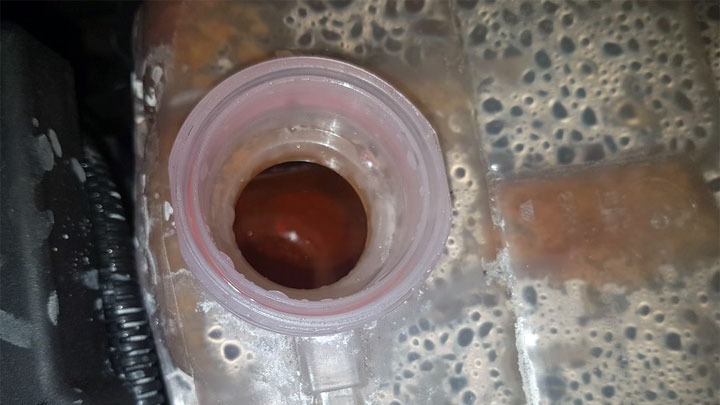
The appearance of oil within an engine’s coolant overflow tank is not to be taken lightly. Continuing to operate a vehicle in this state can lead to a number of operational issues, which most notably include overheating.
At times, the threat of overheating, and the damage that can be caused by overheating as a whole, can be far more concerning than the underlying oil contamination itself.
Once overheated, an engine becomes prone to a number of serious mechanical issues. Of these issues, few are as prominent, or as concerning, as the prospect of a blown head gasket, cracked cylinder head, or compromised engine block. A failure of this type can easily render an engine inoperable, and often requires a costly overhaul.
In any event, the root cause of oil/coolant cross-contamination should be diagnosed and remedied as soon as possible. Doing so will prevent additional damage from arising, much of which can be quite costly to remedy.
If you do not feel comfortable tackling such repairs yourself, an appointment should be made with a trusted service center, at the first available opportunity.
- 5 Symptoms of an EVAP Leak (and Repair Cost) - Apr 27, 2024
- P0480 Code (Symptoms, Causes, and How to Fix) - Apr 19, 2024
- Car Temperature Gauge Stopped Working? (Here’s Why) - Apr 15, 2024
